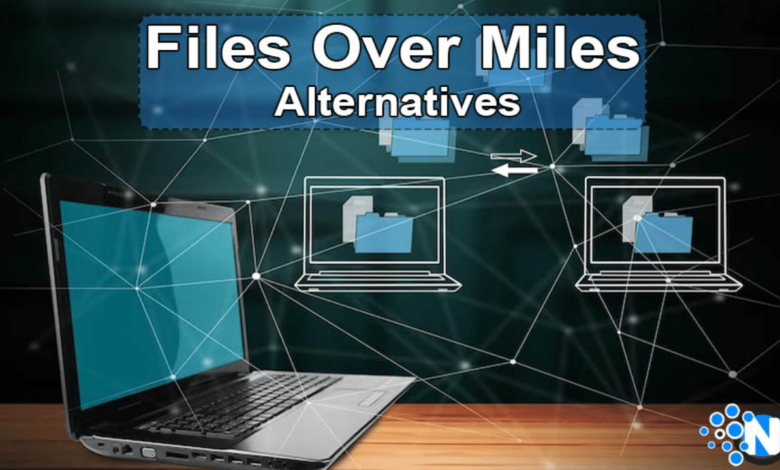Breaking Boundaries with Technology: Managing Files Over Miles

In envisioning files over miles where spatial constraints cease to impose restrictions on the accessibility of vital documents and data, the strides in technological progress have not merely rendered the management of files over miles across distances feasible but imperative in the contemporary expeditious digital epoch. Whether collaborating with associates spanning the expanse of the globe or simply necessitating the retrieval of your data while in transit, the prospect of remote file administration presents unparalleled convenience and efficacy. Let’s delve into how the transcendence of boundaries through technology is fundamentally reshaping the modus operandi of global file handling.
Advancements in technology for remote files over miles management

Gone are the bygone eras of being tethered to a physical server or storage contraption. Through the advent of cloud computing technology, the landscape of remote file management has metamorphosed into a seamless experience, endowing users with the capability to access and disseminate data ubiquitously, tethered only by an internet connection.
The surge of mobile devices has further catalyzed a paradigm shift in how we engage with files over miles from afar. Smartphones and tablets have now transmogrified into potent instruments for overseeing documents, images, videos, and more, all while in motion.
Security fortifications have undergone notable evolution, ensuring the safeguarding of confidential information traversing vast expanses. Encryption protocols and impregnable connections serve as bulwarks, assuaging concerns tied to remote file entry and affording users a sense of tranquility.
Pioneering features such as real-time collaboration orchestrate the symphony of multiple users concurrently refining a singular document, seamlessly fostering collaborative synergy across geographical demarcations. The ceaseless evolution of technology persistently nudges the thresholds of what can be achieved in the realm of remote file administration.
Benefits of managing files over miles
embracing the realm of remote file administration bestows a myriad of advantages upon both individuals and enterprises alike. The convenience of unfettered access to files, irrespective of location or temporal constraints, obliterates the limitations imposed by physical boundaries. This heightened flexibility paves the way for harmonious collaboration among team constituents scattered across diverse geographical points, thereby amplifying overall productivity and efficiency.
Furthermore, the augmentation of data security constitutes a paramount benefit of remote file management, facilitated by the implementation of advanced encryption protocols and impervious access controls. The capacity to seamlessly back up files over miles in real-time on cloud servers substantially diminishes the peril of data loss stemming from hardware malfunctions or unforeseen exigencies. Additionally, substantial cost savings materialize through the alleviation of overhead expenses entwined with conventional physical storage solutions.
Moreover, the embrace of remote file management champions the cause of environmental sustainability by curtailing the dependence on paper-centric documentation and excessive printing practices. Through the digitization of files over miles and the adoption of streamlined electronic workflows, organizations can actively contribute to a greener future while optimizing their operational mechanisms for peak performance.
Challenges and solutions for remote files over miles
Navigating the terrain of remote file management is not without its set of intricacies. Foremost among the concerns is the intricate issue of data security. How can one ensure the safeguarding of sensitive information while it is accessed from disparate locations? Another challenge surfaces in the form of potential conflicts arising from file versioning – how does one avert the scenario where multiple users may inadvertently edit the same document concurrently, leading to a quagmire of confusion?
Fortunately, viable solutions exist to surmount these challenges. Encryption technologies emerge as stalwart guardians, providing a secure conduit for the transfer of files over miles across extensive distances without compromising the sanctity of confidentiality. The implementation of access controls and meticulous permissions stands as a bulwark, permitting alterations solely to authorized individuals concerning specific documents, thereby curtailing the peril of conflicting edits.
Moreover, the vista of cloud storage services unfurls as a centralized nexus wherein all files over miles find abode and can be accessed in real time by remote teams. This not only expedites collaborative endeavors but also serves to curtail the likelihood of issues with version control.
Through a comprehensive comprehension of these challenges and the adept utilization of efficacious solutions, businesses can navigate the labyrinth of obstacles entwined with remote file management, thereby optimizing productivity across expansive distances.
Tools and software for efficient remote files over miles
In the realm of overseeing files over miles across vast distances, the possession of apt tools and software stands as an indispensable facet for the facilitation of seamless operations. Diverse options, tailored to varied needs and preferences, populate the market.
Cloud storage solutions such as Dropbox, Google Drive, and OneDrive present user-friendly avenues for storing, accessing, and sharing files over miles ubiquitously, contingent upon an internet connection. These platforms encapsulate secure file management features that render collaboration across expansive distances an effortless undertaking.
For those seeking more sophisticated functionalities, project management tools like Trello or Asana step into the limelight, aiding teams in task organization, progress tracking, and the consolidation of file storage within a collaborative workspace. Such tools operate as conduits streamlining communication and augmenting productivity by consolidating all pertinent information in a singular locale.
Furthermore, remote desktop applications like TeamViewer or AnyDesk empower users to access their computer desktops from a distance, thereby facilitating facile file transfers and troubleshooting sans physical presence. Particularly invaluable for IT professionals contending with systems situated miles apart.
Through judicious exploitation of these tools, businesses can finely calibrate their processes of remote file management, thereby elevating efficiency and productivity to unprecedented echelons.
Industries that can benefit from remote files over miles
In the dynamic realm of finance, the implementation of remote file management emerges as a pivotal catalyst, streamlining communication and collaboration among global offices. Through the secure dissemination of files over miles spanning vast distances, financial institutions can safeguard data integrity while concurrently heightening operational efficiency.
The healthcare sector stands poised to reap substantial benefits from the adoption of remote file management solutions. Healthcare providers gain facile access to patient records and medical images from any locale, thereby elevating the quality of patient care and alleviating administrative burdens.
For legal entities, the orchestration of file management from a distance translates to augmented flexibility in document retrieval and sharing. Lawyers navigate the landscape of cases seamlessly across diverse locations, unencumbered by concerns over version control or security pitfalls.
In the creative domain, encompassing advertising agencies or design studios, the paradigm of remote file management equips teams to engage in real-time collaboration on projects. This not only amplifies creativity but also augments productivity by obliterating geographical constraints.
Educational institutions too can harness the potential of remote file management for the seamless exchange of resources among students and faculty. This simplifies the dispensation of coursework and feedback processes, culminating in a more streamlined and enriched learning experience.
Future predictions and possibilities for remote files over miles
The future landscape of remote file management teems with exhilarating possibilities, poised to revolutionize the operational dynamics of businesses. Propelled by strides in cloud technology and artificial intelligence, we anticipate a future characterized by even more seamless collaboration on files over miles spanning extensive distances. Envision a scenario where files over miles es are instantly accessible from any corner of the globe with just a few clicks, further optimizing the efficiency of remote work.
As machine learning algorithms undergo continuous evolution, there exists the prospect of witnessing automated organization and categorization of files over miles predicated on user behavior and discernible patterns. Such a development holds the potential to streamline workflows and elevate productivity for teams dispersed globally. Furthermore, the implementation of enhanced security measures assumes paramount importance in safeguarding sensitive data, given the escalating prevalence of file sharing.
In the coming years, the ingress of virtual reality (VR) and augmented reality (AR) technologies could emerge as pivotal players in reshaping how we engage with files over miles remotely. The visualization of intricate data sets or designs within a virtual space could catalyze heightened levels of communication and collaboration among team members toiling from disparate locations. The horizon of possibilities for remote file management appears boundless as technology hurtles forward at an accelerated pace.
Conclusion
In a global landscape where connectivity transcends geographical confines, the management of files over miles across vast distances has evolved into not merely a possibility but a vital necessity for both businesses and individuals. Technological advancements have shattered barriers, paving the way for a seamlessly orchestrated remote file management system that embodies flexibility, security, and efficiency.
In the ongoing embrace of the digital age and the assimilation of novel work methodologies, remote file management assumes an increasingly pivotal role in shaping collaborative endeavors, data storage practices, and ubiquitous information access. Through the strategic utilization of tools and software tailored for effective remote file administration, organizations can rationalize workflows, enhance productivity, and maintain competitiveness in an ever-evolving terrain.
From the expansive realm of cloud storage solutions to the implementation of secure file transfer protocols, the avenues for remotely managing files over miles unfold boundlessly. Industries spanning healthcare, finance, and education stand poised to accrue substantial benefits from the incorporation of remote file management practices. Armed with adept strategies, businesses can surmount challenges encompassing data security apprehensions or restricted accessibility, while concurrently enjoying the dividends of heightened collaboration and centralized data repositories.
Peering into the horizon of remote file management’s future unveils even more promising prospects. As technology hurtles forward at an accelerated pace, we can anticipate the advent of even more sophisticated tools set to further revolutionize the modus operandi of handling files over miles across distances. The potential for automation, integration of artificial intelligence, and bolstered cybersecurity measures herald exciting opportunities for reshaping the landscape of remotely managing files.





